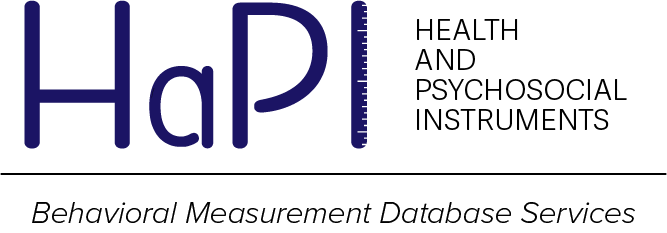HaPI Database
How to Access Research Tools in HaPI Database

The Ovid Experience. Professionals, researchers, students, and information managers in the scientific and health care communities rely on OvidSP for the information they need to explore a new theory, fuel a new discovery, inform ongoing research, and improve patient care. OvidSP provides our online database, customized clinical research, and educational solutions that help each individual and each organization transform information into knowledge. Whether you need the answer to make a decision, a diagnosis, or a discovery; your OvidSP search results will help you decide what to do next.
Our psychological measurement database is second to none. Contact your librarian today or for your free 30 day trail below.
For information regarding the OvidSP free trial, please visit http://www.ovid.com.
- How to search HaPI on OvidSP Click here to learn about accessing the HaPI Database through the OvidSP user Interface. We provide a step by step overview to make your search useful and easy.
- HaPI Database Fields Specific information provided about measurement instruments is listed in separate fields in the Health and Psychosocial Instruments (HaPI) database.
- Primary Source Samples
- Secondary Source Samples
 EBSCO Publishing (EP) is the most prolific aggregation of premium full-text content, offering more than 300 full-text and secondary research databases including HaPI via the EBSCOhost platform. EBSCOhost databases provide unparalleled access to world renowned content in all subject areas, for researchers at every level. EP provides databases to tens of thousands of customers representing millions of end users. Serving upwards of 100 million daily page views, EBSCOhost stands as one of the most used sites on the Internet.
We are proud to offer the best health and psychosocial measurement tools in research through a great service.
For information regarding the EBSCO free trial, please visit http://www.ebscohost.com.
EBSCO Publishing (EP) is the most prolific aggregation of premium full-text content, offering more than 300 full-text and secondary research databases including HaPI via the EBSCOhost platform. EBSCOhost databases provide unparalleled access to world renowned content in all subject areas, for researchers at every level. EP provides databases to tens of thousands of customers representing millions of end users. Serving upwards of 100 million daily page views, EBSCOhost stands as one of the most used sites on the Internet.
We are proud to offer the best health and psychosocial measurement tools in research through a great service.
For information regarding the EBSCO free trial, please visit http://www.ebscohost.com. - How to search HaPI on EBSCO Click here to learn about accessing the HaPI Database through the EBSCO user Interface. We provide a step by step overview to make your search useful and easy.
- HaPI Database Fields Specific information provided about measurement instruments is listed in separate fields in the Health and Psychosocial Instruments (HaPI) database.
- Primary Source Samples
- Secondary Source Samples
What Research Instruments are Included with our HaPI Database?
The HaPI database describes a variety of different kinds of measurement instruments, including:
A Checklist consists of a list of characteristics, behaviors, skills, symptoms, or conditions. Respondents are typically asked to indicate the presence or absence of each item in the checklist. A checklist may be completed by an observer (e.g., nurses recording patients’ compliance behavior, teachers observing children in a classroom setting), clinician, or participant who records each instance that a characteristic, behavior, or skill is exhibited
A Coding Scheme involves the “systematic arrangement of items in an organized fashion or the classification of items into identifiable categories” (APA Dictionary of Psychology, 2007). This type of instrument may focus on the degree or intensity of responses, including frequency of occurrence, and is often used as a method of systematically describing observed behavior, verbal exchanges, and open-ended responses. One type of coding scheme is a content analysis, which is “any procedure in which verbal material – written, tape-recorded, or live – is reduced to numerical data on the basis of a set of rules…” (Stang & Wrightsman, 1981, p. 19)
An Index is a composite (often a ratio) of values or scores that describes a condition or variable that usually cannot be observed directly. An index measure is “any composite measure created by a researcher that combines the values of two or more measured variables or items. Indexes are created to represent an underlying variable more precisely than any single item or measure included in the index would” (Stang & Wrightsman, 1981, p. 46).
An Interview Schedule is an instrument in which an interviewer asks selected questions and then records respondents’ answers in a face-to-face situation or over the telephone. Some interviews are designed simply to measure answers to specific questions; others may involve recording information about participants’ nonverbal behavior during the interaction. A structured interview consists of “a predetermined set of questions or topics” (APA Dictionary of Psychology, 2007, p. 901). An unstructured interview “imposes minimal structure by asking open-ended (rather than set) questions and allowing the interviewee to steer the discussion into areas of his or her choosing” (APA Dictionary of Psychology, 2007, p. 970). In unstructured or semi-structured interviews, the interviewer has flexibility to pose additional questions in order to probe for further details or pursue specific themes.
A Projective Technique is a standardized method to elicit responses to vague, ambiguous stimuli. These stimuli may consist of pictures, ink blots, phrases, incomplete sentences or stories that allow respondents to reply as they wish. This technique is called “projective” because, when asked to describe the ambiguous stimuli, the respondent is believed to “project” his or her feelings, thoughts, or personality onto the stimuli.
A Questionnaire is “a list of questions asked to obtain information about a topic of interest, such as an individual’s lifestyle, attitudes, and other behaviors or characteristics” (APA Dictionary of Psychology, 2007, p. 764).
A Rating Scale is “any scale in which a rater, or respondent, can express an opinion, judgment, or evaluation, usually by placing a mark along a line that is divided into 5 or 7 segments. Likert scales, Likert-type scales, the semantic differential, and graphic rating scales are examples of rating scales” (Stang & Wrightsman, 1981, p. 74). A rating scale is “an instrument used to assign scores to persons or objects on some numerical dimension” (APA Dictionary of Psychology, 2007, p. 769). Rating scales may be nominal, ordinal, interval, or ratio.
A Survey is “a method of gaining certain information by asking specific people specific questions” (Corsini, 1999, p. 966).
A Task is a structured performance situation in which participants engage in an activity and their performance is assessed.
A Test is “a standardized set of questions or other items designed to assess knowledge, skills, interests, or other characteristics of an examinee” (APA Dictionary of Psychology, 2007, p. 931). Common tests include intelligence tests, aptitude tests, cognitive tests, screening tests, and neuropsychological tests.
A Vignette/Scenario is designed to assess people’s reactions to either hypothetical or actual situations. After reading a particular vignette (e.g., a story or description of an interaction between individuals), respondents may be asked questions about the vignette, for example, their attitudes toward the story characters, solutions to conflicts or problems depicted in the vignette, or estimates of how they themselves would behave in a similar situation.
- CHECKLIST
- CODING SCHEME or CODING SYSTEM
- INDEX
- INTERVIEW SCHEDULE
- PROJECTIVE TECHNIQUE
- QUESTIONNAIRE
- RATING SCALE
- SURVEY
- TASK
- TEST
- VIGNETTE / SCENARIO
A Checklist consists of a list of characteristics, behaviors, skills, symptoms, or conditions. Respondents are typically asked to indicate the presence or absence of each item in the checklist. A checklist may be completed by an observer (e.g., nurses recording patients’ compliance behavior, teachers observing children in a classroom setting), clinician, or participant who records each instance that a characteristic, behavior, or skill is exhibited
A Coding Scheme involves the “systematic arrangement of items in an organized fashion or the classification of items into identifiable categories” (APA Dictionary of Psychology, 2007). This type of instrument may focus on the degree or intensity of responses, including frequency of occurrence, and is often used as a method of systematically describing observed behavior, verbal exchanges, and open-ended responses. One type of coding scheme is a content analysis, which is “any procedure in which verbal material – written, tape-recorded, or live – is reduced to numerical data on the basis of a set of rules…” (Stang & Wrightsman, 1981, p. 19)
An Index is a composite (often a ratio) of values or scores that describes a condition or variable that usually cannot be observed directly. An index measure is “any composite measure created by a researcher that combines the values of two or more measured variables or items. Indexes are created to represent an underlying variable more precisely than any single item or measure included in the index would” (Stang & Wrightsman, 1981, p. 46).
An Interview Schedule is an instrument in which an interviewer asks selected questions and then records respondents’ answers in a face-to-face situation or over the telephone. Some interviews are designed simply to measure answers to specific questions; others may involve recording information about participants’ nonverbal behavior during the interaction. A structured interview consists of “a predetermined set of questions or topics” (APA Dictionary of Psychology, 2007, p. 901). An unstructured interview “imposes minimal structure by asking open-ended (rather than set) questions and allowing the interviewee to steer the discussion into areas of his or her choosing” (APA Dictionary of Psychology, 2007, p. 970). In unstructured or semi-structured interviews, the interviewer has flexibility to pose additional questions in order to probe for further details or pursue specific themes.
A Projective Technique is a standardized method to elicit responses to vague, ambiguous stimuli. These stimuli may consist of pictures, ink blots, phrases, incomplete sentences or stories that allow respondents to reply as they wish. This technique is called “projective” because, when asked to describe the ambiguous stimuli, the respondent is believed to “project” his or her feelings, thoughts, or personality onto the stimuli.
A Questionnaire is “a list of questions asked to obtain information about a topic of interest, such as an individual’s lifestyle, attitudes, and other behaviors or characteristics” (APA Dictionary of Psychology, 2007, p. 764).
A Rating Scale is “any scale in which a rater, or respondent, can express an opinion, judgment, or evaluation, usually by placing a mark along a line that is divided into 5 or 7 segments. Likert scales, Likert-type scales, the semantic differential, and graphic rating scales are examples of rating scales” (Stang & Wrightsman, 1981, p. 74). A rating scale is “an instrument used to assign scores to persons or objects on some numerical dimension” (APA Dictionary of Psychology, 2007, p. 769). Rating scales may be nominal, ordinal, interval, or ratio.
A Survey is “a method of gaining certain information by asking specific people specific questions” (Corsini, 1999, p. 966).
A Task is a structured performance situation in which participants engage in an activity and their performance is assessed.
A Test is “a standardized set of questions or other items designed to assess knowledge, skills, interests, or other characteristics of an examinee” (APA Dictionary of Psychology, 2007, p. 931). Common tests include intelligence tests, aptitude tests, cognitive tests, screening tests, and neuropsychological tests.
A Vignette/Scenario is designed to assess people’s reactions to either hypothetical or actual situations. After reading a particular vignette (e.g., a story or description of an interaction between individuals), respondents may be asked questions about the vignette, for example, their attitudes toward the story characters, solutions to conflicts or problems depicted in the vignette, or estimates of how they themselves would behave in a similar situation.
HaPI Database
References
Corsini, R. J. (1999). The dictionary of psychology. Philadelphia, PA: Brunner/Mazel.
Stang, D. J., & Wrightsman, L. S. (1981). Dictionary of social behavior and social research methods. Monterey, CA: Brooks/Cole Publishing Company.
Vanden Bos, G. R. (Ed.). (2007). APA dictionary of psychology. Washington, DC: American Psychological Association.





